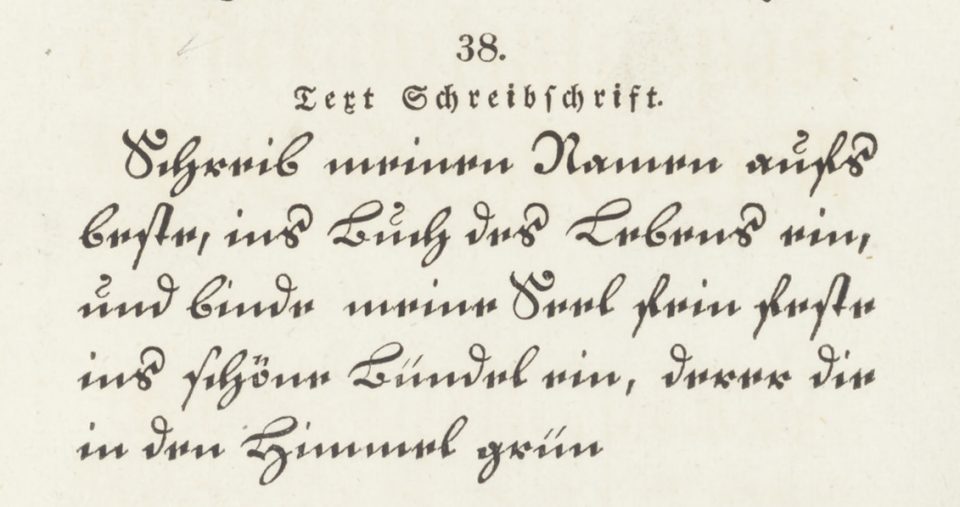Welcome to part one of what will surely be a long, multi-part series on the typefoundries active in Berlin between 1574 and about 1927. In turn, this is part of my Friedrich Bauer project, in which I slowly translate and comment on the text from Bauer’s 1928 Chronik der Schriftgießereien in Deutschland und den deutschsprachigen Nachbarländern. Bauer’s chronicle runs alphabetically through all cities in German-speaking Europe that had typefoundries. Within each city’s section, he listed foundries chronologically, based on their years of establishment.
Bauer’s chronicle is just over 200 pages long. With Berlin, which begins on page 11, we arrive at the first of the “great” typefounding cities. Berlin’s initial foundry opened in the sixteenth century, although the city wouldn’t catch up to Frankfurt am Main or Leipzig for several centuries more. Commercial fonts have not been cast in Berlin since the late 1970s but the city continues to be a global center of type design today. Just as with Augsburg, Bauer’s entries for the Berlin foundries addressed in this post are much longer than in the first edition of his chronicle, Chronik der deutschen Schriftgießereien (1914). As I mention in the notes at the bottom of this post, he may have received that additional information on Berlin foundries from Ernst Crous during the mid-1920s.[1]
This post is essentially limited to the first two Berlin foundries in Bauer’s chronological listing: The in-house typefoundry at Leonhard Thurneysser’s late-sixteenth-century printing house and an erstwhile royal typefoundry established during the 1740s according to the wishes of Prussia’s fabled King Frederick II. Privatized rather quickly, the former Prussian state foundry would eventually pass to the H Berthold AG at the end of the First World War. The next post in my series may be more exciting; it will tackle the Decker and Unger foundries. The latter foundry was established by the francophile Johann Friedrich Unger, not by the late Gerard Unger (1942–2018; also a francophile).
Berlin
Thurneysser
The first Berlin typefounder[2] was the much-cited alchemist Leonhard Thurneysser zum Thurn.[3] Born in Basel on 6 August 1530, he was initially a goldsmith before turning to natural sciences, chemistry, and metallurgy. He made a name for himself through miraculous medical cures on adventurous journeys that took him far beyond Europe. In 1568, he returned to Germany, and two years later, he had the Eichorn printing house in Frankfurt an der Oder produce a large-volume work with many woodcuts and copperplate engravings.[4] In 1571, Elector John George brought Thurneysser to Berlin to be his physician.[5]
1574
Here, in 1574, Thurneysser set up a printing office in the “Graues Kloster,”[6] which he equipped not only with German and roman types but also with many oriental ones. He also added a typefoundry [to his office]. Thurneysser is said to have intermittently employed over two hundred workers in his house.[7] Before setting up his foundry, he obtained types from Frankfurt am Main and Nuremberg, as well as from the Wittenbergers Zacharias Lehmann,[8] Engelbert Krechting’s widow,[9] and Friedrich Berwaldt.[10]
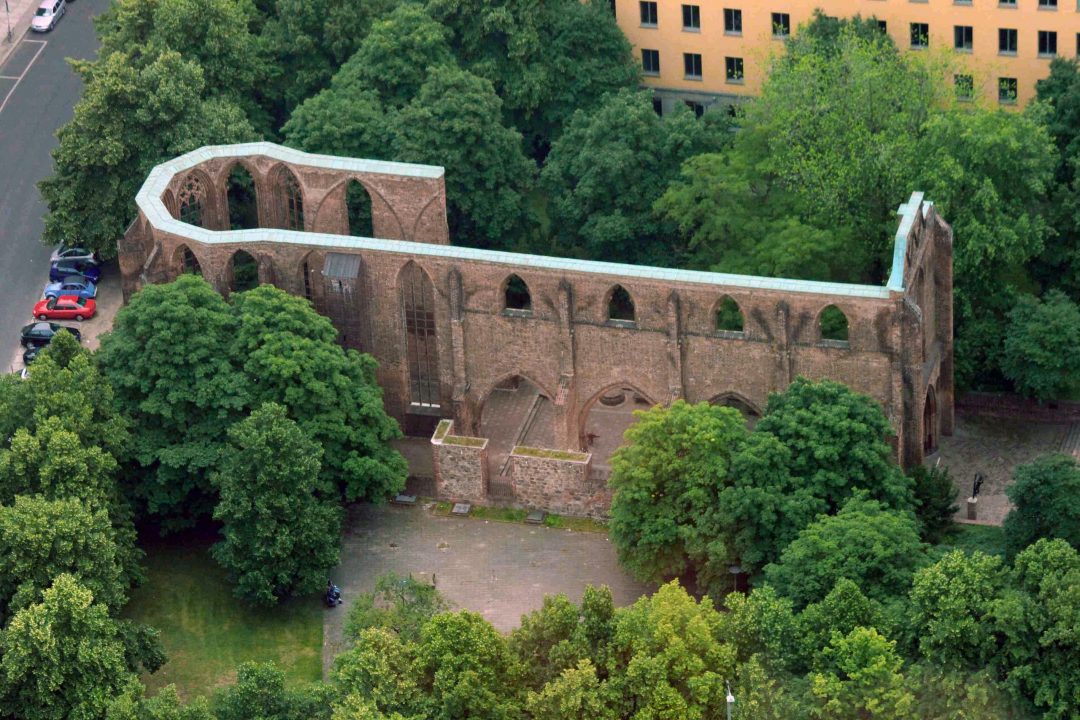
Photograph of the ruins of the abbey church from Berlin’s Graues Kloster, taken in 2012 from Berlin’s television tower. Thurneysser’s Berlin-based business ventures were housed in the former-monastic buildings on the abbey grounds. Wikimedia Commons.
1576
Thurneysser’s own typefoundry began operating around 1576. Its primary concern was cutting and casting oriental types.[11]
1577
In 1577, Thurneysser sold the business for 1,100 thalers to Michael Hentzke, his composition foreman. Hentzke, who had been born in Bürgel near Jena, died in 1580. He left the business to his widow, who married the printer Nikolaus Voltz in 1582. Voltz, born in Erfurt in 1551, continued to run the [Thurneysser/Hentzke] business. At this time, the typefounder Veit Bretschneider was responsible [for the foundry’s] casting, while the Berlin goldsmith Andreas Hindenberg cut the type.[12]
A kind of type specimen (six sheets A to F) was published in 1583 with the title Tabula Quarundam Syllabarum … omnia per Leonhardum Thurneysserum zum Thurn … in lucem edita … Gedruckt zu Berlin durch Nicolaum Voltzen. Anno 1583.[13]
Thurneysser still had certain shares and supervisory rights in the printing house until 1583, then he began a restless life again and died in a monastery at Cologne in 1596.
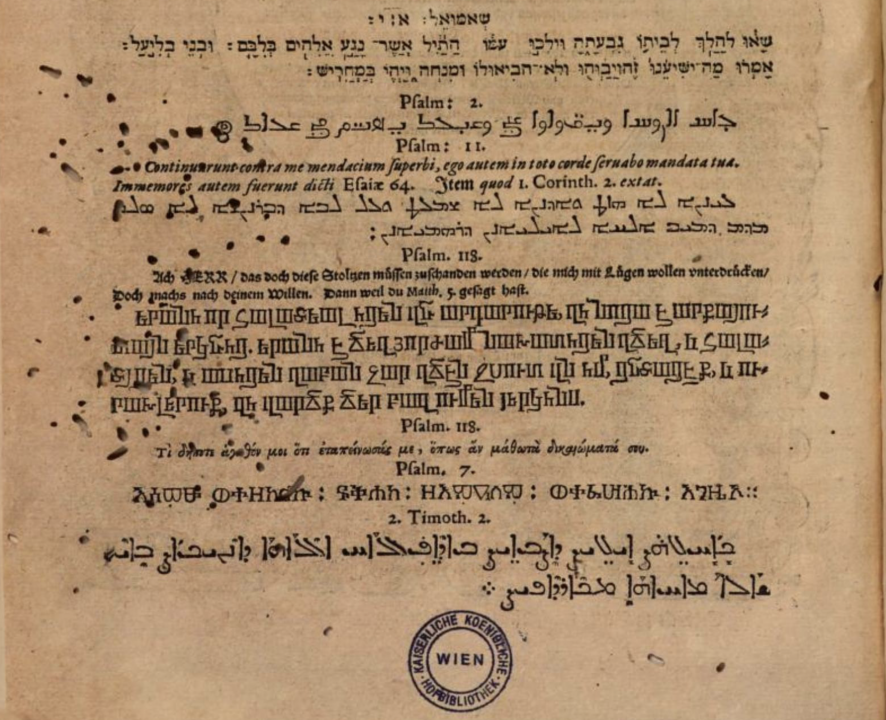
Sample showing seven scripts (including the Latin script in multiple typefaces) used by Thurneysser on his press. This isn’t the “specimen” that Bauer mentioned above, but it is a more-specimen like showing of the press’s types for other scripts. Image from Megalē Chymia, Vel Magna Alchymia, printed by Thurneysser’s successor Nikolaus Voltz at Berlin in 1583. Digitized by Google Books from a copy in the Austrian National Library at Vienna.
1593
In the second half of 1593, Voltz moved the business to Frankfurt an der Oder, where he died in 1619. Where the typefoundry remained is not known. The printing house passed to Voltz’s son-in-law Michael Koch, who was born in 1577 at Pegau and died in 1645. Koch’s son Nikolaus (born 1611, died 1653) was appointed university printer.
Königliche Schriftgießerei (Schmidt) – J. G. Francke – Tech
At the instigation of Frederick the Great,[14] a typefoundry was established up in Berlin in 1742. This was to be based on the model of the royal printing house in Paris and equipped with punches, matrices, and moulds. C. F. Simon, printer to the Archbishop of Paris,[15] had to prepare a design for a Royal Prussian printing office. A renowned punchcutter from The Hague, Johann Michael Schmidt, was entrusted with its management. However, unexpected wars and Schmidt’s death in 1750 brought the firm to a standstill.[16] So reads the account of Fournier le jeune in the preface to his Manuel Typographique 1766.[17]
The Parisian printer Claudius Franz Simon[18] presented above-mentioned plans to King Frederick II in 1741 in the form of a printed and magnificently bound large folio volume. Not only did it foresee for the establishment of a typefoundry but also a printing office with 12 presses. The rejection of this outline must have occurred not only because it went far beyond the king’s intentions but also because Simon consistently demanded prices double or triple the costs usual at the time. It has been recalculated that, out of a total estimate of 370,000 livres, about 150,000 livres were earmarked for pocket money. This exorbitant project, which Gottsched[19] reprinted in Büchersaal der schönen Wissenschaften in 1746,[20] seems to have been ignored by Frederick II. He consigned the folio to Privy Councilor Jordan,[21] who gifted it to a salesman. Later, it came into the possession of the well-known Leipzig printer J. G. I. Breitkopf.[23] Since his library it was auctioned off in 1795, the folio’s location is now unknown.[24]
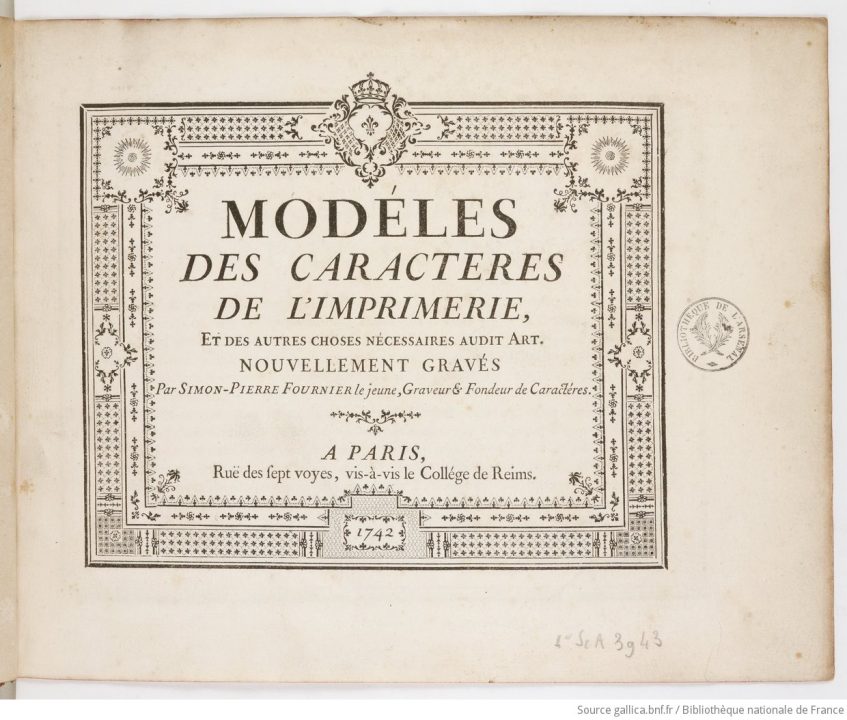
This is quite a stylistic jump from the previous image. Above, I’ve reproduced the title page of Simon-Pierre Fournier’s 1742 specimen, the Modéles des caractères de l’imprimerie. Frederick II could have had Fournier-style typefaces in the early 1740s, had the War of the Austrian Succession not gotten in the way. Typefoundries established in Berlin a few decades later did receive Parisian types, particularly from Joseph Gillé and the Didots, but you will have to wait for my next post to read about that. Image from the Bibliothèque nationale de France, digitized here.
1740, 1742
The idea to found a royal typefoundry actually came in 1740 from the typefounder Johann Wenzel Hablitzl, who had worked as a journeyman in Halle for ten years and wanted to become self-employed.[25] On 13 August 1740, he requested that the king purchase the bankrupt typefoundry of Johann Barthold Kirchner’s heirs in Braunschweig and entrust him with its operations in Königsberg. The foundry was acquired on 16 August 1742 for 600 Reichsthaler. However, it was first brought to Berlin, where the typefounder Johann Michael Schmidt, appointed from The Hague, would divide it into two parts. One would form the basis of a royal typefoundry to be founded in Berlin, while the other would be entrusted to Hablitzl in Königsberg.[26] The Berlin portion was supplemented by Schmidt’s own punches and matrices obtained abroad (e.g., Frankfurt am Main and Wittenberg). Frederick II tried to promote the business, among other ways, by instructing his country’s printers on 19 January 1747 to only obtain punches, matrices, and types from his Berlin typefoundry and assured them of their respective freedom from excise taxes, clearance fees, and import duties. The foundry worked well, albeit on a small scale, but after Schmidt died on 20 June 1750, it fell into disrepair under the management of his son Johann Schmidt and closed in 1752.
Johann Michael Schmidt had trained as a punchcutter and typefounder in the Luther typefoundry at Frankfurt am Main and also cut punches for Wetstein in Amsterdam. In 1728 and 1729, he was in The Hague, where he cut dies for Uytwerf & Alberts and set up a foundry. He is said to have been in Berlin for some time.[27] It is not known when he returned to The Hague, but what is certain is that he was called to Berlin with his son by Frederick the Great in 1742 and died there in 1750.[28]
After he left Berlin in 1752, Johann Schmidt spent ten year working for Breitkopf in Leipzig,[29] then for seven for Cotta in Stuttgart before arriving at the Luther foundry in Frankfurt am Main as a punchcutter. The he established a foundry in Rotterdam that issued specimens in 1780 but folded soon afterwards.[30]
1752
On 27 August 1752, Frederick II allocated the inventory of the royal typefoundry “to the punchcutter and typefounder Johann Ludwig Zinck, who had settled here from Wittenberg in Saxony, for 300 thalers [with the rights for his heirs to inherit ownership].”[31] Zinck (born 17 July 1728), was the son of the Wittenberg typefounder Christian Zinck.[32] He brought the foundry back on track, casting not just for Berlin printers but also for those further afield. Because of his unsuccessful attempt to set up a printing house, he [began neglecting the] foundry. When he died in 1770, it had declined greatly.
1770, 1810, 1825, 1872[33]
Zinck’s sister, who inherited the foundry from him, transferred it to her husband, the punchcutter and typefounder Johann Gottlob Franck. The King confirmed his ownership on 13 September 1770. He managed to improve [the foundry]. In 1790, he worked with nine journeymen and boasted of the best letters in Germany.[34] He died aged 68 on 16 April 1810 as Court typefounder. His second wife and his son Gottlob Francke (born 14 June 1786) were his heirs. The latter published a specimen in 1825 that showed a rich collection of good typefaces.[35] The foundry, which operated with five furnaces in 1854, was passed down through the family to the next generation before being sold in 1872 to the A. W. Kafemann printing house in Danzig. There, it continued for 30 years under the name J. G. Francke Nachfolger.[36]
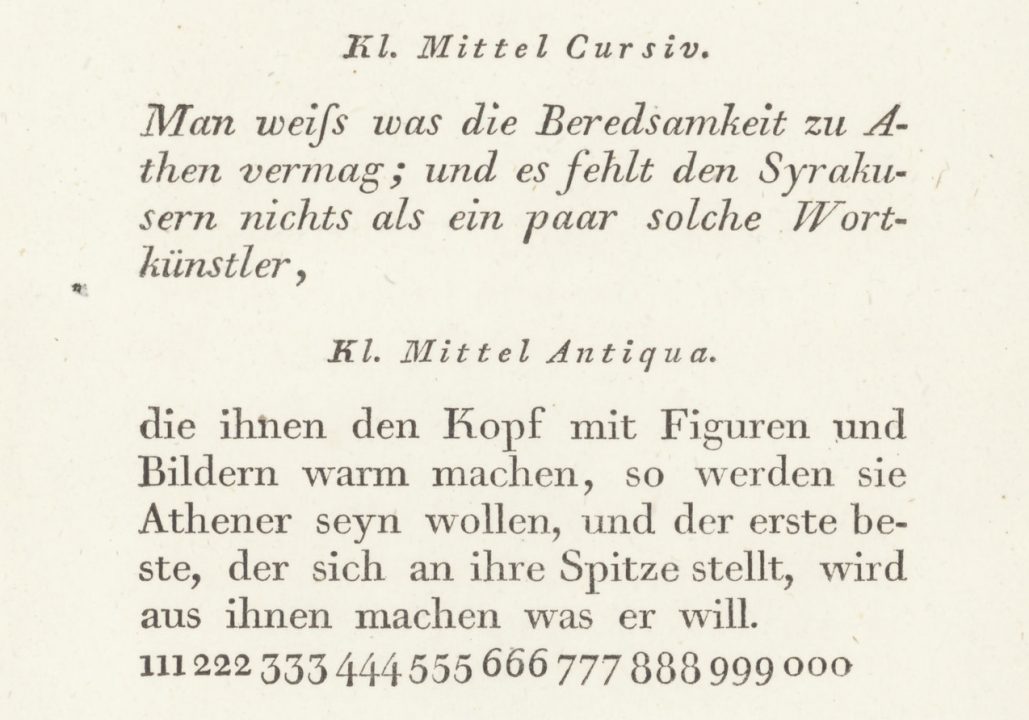
Two approximately 14-point typefaces in the Didot style from Francke’s 1825 specimen. The text is from Christoph Martin Wieland’s 1766/67 novel Geschichte des Agathon. Digitized by the Staatsbibliothek zu Berlin – Preußischer Kulturbesitz. The image in this post’s header is also from that specimen.
1912, 1917
In 1912, the J. G. Francke Nachfolger typefoundry returned to Berlin after the Otto Tech typefoundry purchased it and merged both operations. In turn, Emil Gursch and H. Berthold AG took that over in 1917.[37] Later in the same year, the Emil Gursch foundry was acquired by H. Berthold AG, making it the ultimate successor of the first Prussian state foundry.
Halle – Kanter
1750
In 1750, the Christian Wilhelm Halle typefoundry in Berlin was sold to Alexander Kanter in Königsberg “for more than 300 Reichstaler.” It is not clear when this foundry was founded and whether Halle is the Berlin type founder who appears in Berlin files in 1730 and 1740 without being named.[38]
Notes
- Ernst Crous, Die Schriftgießereien in Berlin von Thurneysser bis Unger. Nach handschriftlichen und gedruckten Quellen dargestellt (Berlin: H. Berthold AG, Abteilung Privatdrucke, 1928).
- Bauer’s entry for Thurneysser in the 1928 edition of his book is about three times the length of the first edition’s. Since he did not go into state archives to research himself, Crous’s histories of Berlin printing and typefounding may have been his sources for the additions. For instance, Bauer may have read August Potthast’s Geschichte der Buchdruckerkunst zu Berlin im Umriss, edited by Ernst Crous (Berlin: Verein Berliner Buchdruckerei-Besitzer, 1926), or the book mentioned in previous note. Although published in 1928 – the same year as Bauer’s expanded second edition – the Thurneysser section in that book had already been completed in 1922 (p. xi). Alternatively, Bauer may have taken his basic biographical information on Thurneysser from other secondary sources. His language is similar to that used in Rudolf Schmidt’s entry on Thurneysser for Deutsche Buchhändler, Deutsche Buchdrucker. Beiträge zu einer Firmengeschichte des deutschen Buchgewerbes 5 (1908), pp. 948–950. Schmidt’s source for the information he cited was probably the Archiv für Geschichte des deutschen Buchhandels.
- The most-recent book on Thurneysser is Gabriele Spitzer’s …und die Spree führt Gold. Leonhard Thurneysser zum Thurn. Asologe – Alchemist – Arzt und Drucker im Berlin des 16. Jahrhunderts (Berlin: Staatsbibliothek zu Berlin – Preußischer Kulturbesitz, 1996). His basic biographical details can be found in German from Urs Leo Gantenbein’s »Thurneisser zum Thurn, Leonhard« in Neue Deutsche Biographie 26 (2016), pp. 232–234 [online version]. The English-language Wikipedia entry seems quite OK, too.
- This was Thurneysser’s Προκατάληψις Oder Praeoccupatio, Durch zwölff verscheidenlicher Tractaten, gemachter Harm Proben, printed by Johan Eichorn in 1571, which Google Books has digitized. A year later, Eichorn printed a second Thurneysser book, Pison. 1: Das erst Theil Von kalten, warmen, minerischen und metallischen Wassern, sampt der Vergleichunge der Plantarum und Erdgewechsen, digitized here; see Spitzer 1996, p. 20 (note 3 above).
- John George (1525–1598) was Elector of Brandenburg from 1571 until his death.
- This was a Franciscan monastery that closed once the Reformation came to Berlin. Ruins of the monastery’s church building still stand in Berlin, not far from Alexanderplatz.
- Regarding the “over two hundred workers in his house,” Bauer’s text is misleading. Some texts immediately preceding Bauer’s were even worse. For instance, Schmidt 1908 (note 2 above) states that “the importance of his printing house is evident from the fact that, at its peak, it sustained over 200 workers.” That is absolutely preposterous and would mean that Thurneysser’s printing house would have been the largest in the world. Plantin’s press, by comparison, was a gigantic one for the age – and he “only” had 80 employees. Thurneysser had about 200 people in his household. That included family members, servants, and the employees from all his business ventures; see Spitzer 1996, p. 23 (note 3 above). The number of workers in his printing press must have been much fewer than at Plantin’s. In Thurneysser’s time, Berlin may have only had 10,00 residents. Even by the beginning of the nineteenth century, when the number of Berlin residents had risen more than ten-fold, its printing houses had nowhere near 200 employees. In 1805, Berlin’s then-largest printing house was Deckers’s, and that only employed “89 workers, including nine in its typefoundry;” see Nikolaus Weichselbaumer, »Die Druckerfamilie Decker und die klassizistische Typographie in Berlin um 1800« in Imprimatur. Ein Jahrbuch für Bücherfreunde. Neue Folge XXV (München: Gesellschaft der Bibliophilen, 2017) pp. 249–268, here p. 253.
- Zacharias Lehmann was a printer in Wittenberg, at least from 1575 onward.
- Her name was Anastasia Krechting; see Crous 1928 p. 10 (note 1 above). Anastasia and Engelbert Krechting’s last name was also spelled “Kreffting.” Eneglbert Krechting/Kreffting comes up in Bauer’s section on Wittenberg. He worked as a typefounder there from 1570 until he died in 1573; see Daniel Berger and Sophia Linda Stieme, »Die Wittenberger Letternfunde aus der Bürgermeisterstraße 5. Eine typographische, historische und materialkundliche Betrachtung« in Harald Müller (ed.), Glas, Steinzeug und Bleilettern aus Wittenberg (Halle: Landesmuseum für Vorgeschichte, 2014), pp. 267–364, here p. 336. The article can be accessed online at Research Gate.
- Friedrich Bärwalde was another Wittenberg typefounder. He died in 1589; ibid.
- Crous 1928 p. 17 (note 1 above) lists these. Here is my shaky translation: “Greek, Latin, German [and French …], Archaic Hebrew, Hebrew, Chaldean, Abyssinian, Ethiopian, Syriac, Phoenician, Arabic, Punic, Armenian, Dalmatian or Glagolitic, Russian or Muscovite, Jakobitisch [no idea! Syriac is already mentioned twice] or Georgian, Ancient Egyptian [he probably meant Coptic], Indic [Sanskrit?], Persian, Median, Turkish, Tatar, and Old Syriac.”
- In Bauer’s 1914 your edition, he wrote that “Hindenburg cut […] the punches for some Hebrew and other types.” These specifics are missing in the 1928 edition, although this might explain the word “oriental,” mentioned two times above.
- The Staatsbibliothek zu Berlin has digitized its copy of this. As Bauer suggests, is not a type specimen in the sense we understand them today. To illustrate the Thurneysser foundry’s types, Crous 1928 (note 1 above) used part of a page from Thurneysser’s 1583 Megalē Chymia instead. It looks more like a specimen in the sense of Ratdolt’s.
- This is King Frederick II (Friedrich II.), called “the Great.” Born in 1712, he reigned as King in Prussia from 1740 until his death in 1786.
- The Archbishop of Paris at this time was Charles-Gaspard-Guillaume de Vintimille du Luc (1655–1746, in office 1729–1746).
- I assume this refers to the War of the Austrian Succession and the conflicts within it instigated by Frederick the Great: the First and Second Silesian Wars.
- Fournier’s account of this, in Harry Carter’s translations, reads that “the King of Prussia, wishing to establish a Royal Typography upon the model of the that of the King of France, gave orders for the punches, matrices, and moulds for the necessary foundry to be sought in Paris, as a basis for this establishment. M. Simon, Printer to My Lord the Archbishop, consulted upon this project, wrote and printed in 1741, a Proposal for the Setting up of a Royal Printing-House at Berlin, which was sent to the King with the complete specimen of my letters, destined for the formation of this Foundry. But this project not being realized, the King fetched to Berlin a letter-cutter of the town of Hague, named Johann Michael Schmidt, with orders to build up a Royal Foundry; but the supervening wars and the death of this letter-cutter in 1750 have suspended the establishment.” See Pierre-Simon Fournier le jeune, The Manuel Typographique of Pierre-Simon Fournier le jeune. Together with Fournier on Typefounding, an English Translation of the Text by Harry Carter in Facsimile. With an Introduction and Notes by James Mosley (Technische Hochschule Darmstadt, 1995) vol. 2, pp. xxxiii–xxxiv and vol. 3, p. 270.
- His name was Claude-François Simon.
- Johann Christoph Gottsched (1700–1766).
- This has been digitized here see also the discussion on the matter earlier in the same issue of the journal.
- This must by Charles Étienne Jordan (1700–1745), who Frederick II named as one of his privy councilors after his accession in 1740.
- Breitkopf was one of the leading typefounders in Germany during the second half of the eighteenth century. If you can’t wait until I get to Bauer’s entry for him in the chronicle’s Leipzig section, see my translation of his 1777 essay on Enschedé’s 1768 specimen, with an introduction and notes, for details.
- Three copies of the Projet de l’établissement d’une imprimerie royale à Berlin are at the Bibliothèque nationale de France. According to James Mosley’s notes to Harry Carter’s translation of Fournier’s Manuel Typographique, the copy of Fournier’s Modèles that Breitkopf received along with Simon’s folio is at the Kungliga Biblioeket in Stockholm; see Fournier vol. 3 p. *367 (note 17 above).
- Hablitzl had a fascinating biography. I’m putting the cart before the house but he ran a foundry in Königsberg during the Seven Year War. After the Russian Army took the city, he switched sides and moved his foundry to Riga and later Moscow. Nikolaus Weichselbaumer gave a lecture on Hablitzl at the Leipziger Typotage in 2022. Video of his presentation is not online Perhaps it will be posted by the time I get to Königsberg?
- Königsberg was located in East Prussia. Today, it is known as Kaliningrad, part of a Russian enclave between Poland and Lithuania.
- Bauer continued the story of Hablitzl’s typefoundry in his entry for Königsberg’s foundries. For more detail than he offers, see Ernst Crous, Die Schriftgießereien in Königsberg unter Friedrich dem Großen 1740 bis 1766. Nach archivarischen Quellen dargestellt (Berlin: H. Berthold AG, Abteilung Privatdrucke, 1926) pp. 1–32.
- Schmidt’s whereabouts for the duration between 1729 and 1742 are not known. Crous 1928 pp. 12 and 26 (note 1 above) addresses that King Frederick William I summoned him to Prussia in 1729. City statistics for 1730 also note a typefounder resident in Berlin. However, Schmidt seems to have returned to The Hague, wherefrom King Frederick II summoned him in 1742.
- Just as with his entry on Thurneysser, Bauer’s entry for this typefoundry was considerably expanded in his 1928 edition. I suspect that he must have had advance information from Crous’s book of the same year.
- According to Crous 1928 p. 32 (note 1 above), he cut the first punches for Breitkopf’s musical notation types. Finished in 1755, these slightly predate the musical notation types from Fournier and Fleischmann’s for Enschedé.
- I cannot find these in John A. Lane, Mathieu Lommen and Johan de Zoete, Johan (des.), Dutch typefounders’ specimens – From the Library of the KVB and other collections in the Amsterdam University Library, with histories of the firms represented (Amsterdam: De Buitenkant, 1998).
- Bauer’s text reads erb- und eigentümlich although the actually deed, cited by Crous 1928 p. 43 (note 1 above), only contains the word »eigenthümlich«. However, the right of Zinck’s heirs to inherit was mentioned elsewhere. As Crous noted [p. 45], this represented a privatization of the state foundry.
- Johann Ludwig Zinck was also the brother of Christian Gottlob Zinck, briefly mentioned in Bauer’s Augsburg entries.
- 112 years in just a single-paragraph entry is crazy, right?
- Crous 1928 p. 47 (note 1 above) states that his customers included not only printers in Prussia, but also the he “delivered German and French [style types to] Sweden, Poland, Hamburg, Altona, etc.”
- The Staatsbibliothek zu Berlin has a copy of this specimen, which was digitized as part of the big Berlin type specimen digitization project of 2021/22. The types in the specimen that appear uncannily similar to Didot’s are apparently “copies” cut by Johann Gottlob Frank. See Eckehart SchumacherGebler, »Der Einfluß Bodonis und anderer ausländischer Schriftschneider auf die Entstehung klassizistischer Druckschriften in Deutschland« in Gutenberg-Jahrbuch 68 (Mainz: Gutenberg-Gesellschaft e. V., 1993), pp. 173–209, here pp. 182–183.
- Nachfolger is the German word for “successors,” as in: J. G. Francke’s Successors.
- The Berlin-based typefoundries Otto Tech, Emil Gursch, and H. Berthold AG will all be addressed, in turn, by this series soon.
- Bauer did not include this entry in the chronicle’s first edition. His suggestion that Christian Wilhelm Halle was the typefounder mentioned as being present in Berlin represents an alternative possibility, should Johann Michael Schmidt have remained in The Hague or quickly returned after a 1729 visit; see note 27 above.
